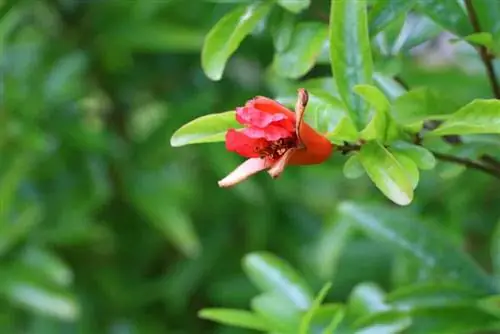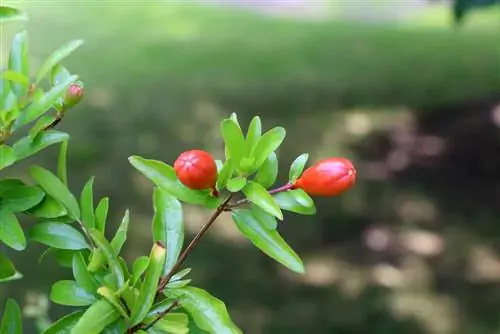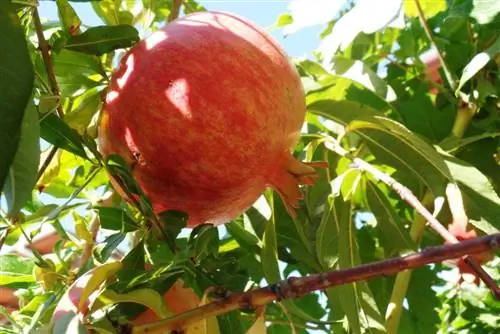- Author admin [email protected].
- Public 2023-12-17 03:39.
- Last modified 2025-01-24 12:45.
Lavish bell-shaped flowers, spectacular fruits and a biblical life expectancy are the outstanding attributes that characterize a pomegranate tree. If the Mediterranean ornamental and fruit tree is given expert care, its picturesque flower magic will also unfold north of the Alps. Even the harvest of the furious pomegranates is within reach. These instructions will familiarize you with all aspects of perfect cultivation in the bucket. This is how you properly care for and overwinter the pomegranate.
Location in spring and summer
The distribution area of the pomegranate tree extends across Central and Western Asia as well as the sun-drenched regions of the Mediterranean. Consequently, a Punica granatum has not learned to thrive in winter conditions. This circumstance requires special conditions at the location so that the beautiful flowers and distinctive fruits appear in large numbers. How to place the pot correctly in the garden and on the balcony:
- Full sunny, warm location with at least 3 to 4 hours of sunshine
- Ideally protected from wind and rain
- Temperatures not below 5 degrees Celsius even at night
The pomegranate tree is said to be able to tolerate short-term minus temperatures of -10 degrees Celsius without harm. However, putting it to the test is not recommended, especially for young, poorly hardy potted plants. Therefore, please only clear out the tree when nighttime temperatures are proven to be around 5 degrees in spring. A minimum-maximum thermometer at the intended location shows when the plant can move into its outdoor space. Since the crown is still without leaves at this time, prior acclimatization in a partially shaded place is unnecessary.
Tip:
In mild climate regions in hardiness zones 7 and 8, you can plant a pomegranate tree outdoors. Provided that it is in a sunny and protected location, the plant can survive temperatures down to -10 degrees Celsius in a wind-protected location. Transparent, breathable protection against constant winter wetness caused by snow and rain is also essential.
Substrate
In its Asian, subtropical and Mediterranean distribution areas, the pomegranate tree prefers to thrive on permeable, sandy and nutrient-rich soils. The better the substrate in the pot simulates this soil quality, the more vital growth and flowering will be. We recommend a high-quality, peat-free pot plant soil as a substrate. A high proportion of peat is highly questionable, and not just from an environmental protection point of view. In addition, potting soil containing peat loses a lot of its water-holding power once it dries out. By using a substrate mixture of green waste compost, wood fibers and bark humus, you offer your exotic flowering plants ideal living conditions.
Tip:
Pomegranate trees from the hardware store or garden center are often in normal, peat-rich potting soil. For the perfect start in your new home, repot your newly purchased Punica granatum into the substrate recommended here as soon as possible.
Pouring

Long before the flowering period begins in June, the pomegranate shines with a dense dress of soft, lush green leaves. The degree of evaporation is correspondingly high in full sun. Regular watering is therefore one of the key functions in the care program. How to do it right:
- Water abundantly and regularly as soon as the substrate surface has dried
- Water thoroughly to ensure constant moisture inside the root ball
- Pour out the coaster after 10 minutes to avoid harmful waterlogging
- Let the soil dry to the touch until the next watering session
Please primarily use filtered rainwater or stale tap water. Under the influence of the blazing midday sun, a pomegranate tree should only be watered in exceptional cases, for example if it is threatened by acute drought stress and loses its leaves. Instead, water in the early morning hours and again in the evening if necessary. Do not overwater the plant, but rather let the water from the watering can run directly onto the root ball.
Fertilize
The summer nutrient requirement is just as high as the water requirement. Therefore, fertilize a pomegranate weekly from March to September. For this purpose, add a liquid fertilizer to the irrigation water according to the manufacturer's instructions. If the substrate is dry, please water with clear water beforehand. This caution prevents the s alts contained from damaging the dried roots. Commercially available fruit and berry fertilizers as well as special citrus fertilizers in liquid form are ideal for nutrient supply.
If the ornamental tree signals a weakened constitution by dropping leaves or brown leaf edges, pause the application of fertilizer. Disturbances in metabolism impair the absorption of nutrients, so that an excess of s alts accumulates in the substrate, which results in root damage. Only when problems in cultivation have been resolved will the nutrient supply begin again.
Cutting
The pomegranate is characterized by the growth of its pretty bell-shaped flowers in terminal clusters. This characteristic implies that pruning has serious consequences. If you cut off the branches in the summer, you will at the same time end all hopes of the longed-for pomegranates in the fall. If you pull out the scissors in spring, most of the buds will fall victim to this year's flower festival. We have summarized the conditions under which a cut makes sense below:
- The best time is during winter rest between December and March
- Cut back shoots that are too long by up to two thirds
- Cut just above a leaf node or bud
- Thin out dead branches at the base
- Remove shoots that are too close together, crossing each other and pointing inwards
You can effectively prevent baldness and aging if you cut off the two oldest shoots at the base every 2 years. This measure creates space for new growth so that continuous rejuvenation takes place. At the same time, the bush or crown cannot become bare because the light can penetrate deep into the interior of the plant.
Tip:
Pruning in the middle of winter is associated with an increased risk of pest infestation. Therefore, carefully disinfect the blades of the tool. Contaminated scissors and saws are the most common causes of all kinds of infections on pomegranate trees.
Wintering

When the temperatures drop in autumn, the pomegranate tree sheds its leaves. This property makes overwintering north of the Alps much less complicated than for evergreen ornamental and fruit trees from southern Europe. Without the leaves, water requirements are reduced. At the same time, the nutrient supply drops to zero. Determining the right time to move to winter quarters is still the most difficult criterion in the wintering program. How to successfully guide a pomegranate tree through the winter:
Don't clear up too early
The pomegranate tree is one of the illustrious circle of Mediterranean plants that can tolerate temperatures below freezing for short periods of time. Therefore, there is no need to rush when autumn arrives. On the contrary, you will significantly impair the plant's resistance by moving to winter quarters too early. The longer a Punica shrub can soak up fresh air and sunlight, the better prepared it is for the rigors of the dark season. Please only bring the bucket in when the mercury drops below zero at night. First remove the remaining leaves if they have not yet fallen off.
Winter care on the back burner
In the ideal winter quarters there is a combination of coolness and light. Please do not expect your pomegranate to overwinter in a well-heated, dim living space. Even the seemingly cool, unheated bedroom can still be too warm. Instead, choose a bright location with temperatures between 5 and 10 degrees Celsius. How to properly care for a pomegranate tree in winter:
- Do not fertilize from October to February
- In winter, water little by little so that the root ball does not dry out
- Check regularly for pest infestation
Where there is no unheated winter garden or a cool greenhouse for wintering, an unheated staircase serves as a suitable alternative. Place the bucket as close as possible to a window that is not tilted to ventilate the room. Alternatively, overwinter your valuable pomegranate tree in a special overwintering tent with an integrated frost monitor in a bright location in the garden or on the balcony.
Don't clear out too late
Correctly clearing out pomegranates takes place in the opposite direction than putting them away. The earlier your exotic winter guests can leave the house, the better for growth, he alth and flowering. To determine the optimal time, a minimum-maximum thermometer is used. Here you can read in the morning what lowest point the mercury column reached the night before. If the nighttime temperatures in March/April do not fall significantly below freezing point within a week, remove the plant. Due to its mobility as a container plant, you can bring the shrub or tree into the house overnight if necessary if the meteorologists announce a late onset of winter.
Repotting

At intervals of 2 to 3 years, a pomegranate tree has roots completely rooted through its container. If the roots push through the surface of the substrate or grow out of the opening in the ground, the care program is expanded to include moving to a larger pot. The best time for the measure is after pruning or before clearing out in spring. The new pot should offer the root ball two fingers' width of space up to the edge of the container. At least one opening in the bottom of the pot for water drainage is essential. A 3 to 5 cm thick drainage made of expanded clay or clay shards prevents waterlogging. How to professionally repot a pomegranate:
- Use a long knife to remove the root ball from the pot wall
- Lay the pot on its side to cut off any roots that have grown out
- Hold the pot with one hand while the other hand grasps the root neck
- Slowly pull the plant out of the pot
- Shake off the old soil, if necessary remove any coarse chunks with your fingers
If the root ball is in front of you without any substrate, this is an excellent opportunity to cut out dead roots. Now fill a few handfuls of potted plant soil into the new pot and position the root ball in the middle of it. While you stabilize the plant with one hand, gradually add more substrate with the other hand. The previous planting depth should be retained, as should a watering edge of 2 to 3 cm. Finally, water the pomegranate tree with soft, room temperature water. Fresh substrate has a supply of nutrients for around 6 to 8 weeks. Only after this time does the weekly administration of fertilizer begin.

